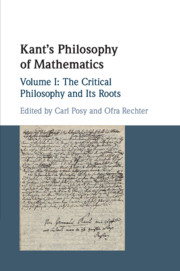Book contents
- Kant’s Philosophy of Mathematics
- Kant’s Philosophy of Mathematics
- Copyright page
- Dedication
- Contents
- Contributors
- Acknowledgements
- Introduction
- Part I Roots
- 1 Kant and Mendelssohn on the Use of Signs in Mathematics
- 2 Of Griffins and Horses
- 3 Kant on Mathematics and the Metaphysics of Corporeal Nature
- Part II Method and Logic
- Part III Space and Geometry
- Part IV Arithmetic and Number
- References to Works by Kant
- Bibliography
- Index
1 - Kant and Mendelssohn on the Use of Signs in Mathematics
from Part I - Roots
Published online by Cambridge University Press: 24 April 2020
- Kant’s Philosophy of Mathematics
- Kant’s Philosophy of Mathematics
- Copyright page
- Dedication
- Contents
- Contributors
- Acknowledgements
- Introduction
- Part I Roots
- 1 Kant and Mendelssohn on the Use of Signs in Mathematics
- 2 Of Griffins and Horses
- 3 Kant on Mathematics and the Metaphysics of Corporeal Nature
- Part II Method and Logic
- Part III Space and Geometry
- Part IV Arithmetic and Number
- References to Works by Kant
- Bibliography
- Index
Summary
This paper concentrates on Kant’s precritical prize essay, Inquiry Concerning the Distinctness of the Principles of Natural Theology and Morality, (1763; published 1764). In the prize essay Kant first emphasizes the essential use of symbols in mathematics as opposed to philosophy. Dunlop argues that in his account of the mathematical use of symbols, Kant has the materials to explain those symbols’ extramental reference. Hence symbolization at least partially fulfills the function assigned to sensible intuition in Kant’s critical philosophy. By comparing Kant’s views in the prize essay with those of Moses Mendelssohn, taken as a representative of the still-dominant Wolffian approach, this paper shows that Kant’s account of the use of symbols makes use of resources already available in the Wolffian tradition. Their familiarity raises the question of what is novel in Kant’s prize essay, and the correspondence between the essay and the first Critique invites us to ask what purpose is served by introducing a faculty of intuition. Dunlop claims that Kant’s view of pure intuition as a condition on empirical intuition is the most important development in the critical account of mathematical discourse’s extramental reference.
Keywords
- Type
- Chapter
- Information
- Kant's Philosophy of Mathematics , pp. 15 - 34Publisher: Cambridge University PressPrint publication year: 2020
- 1
- Cited by



